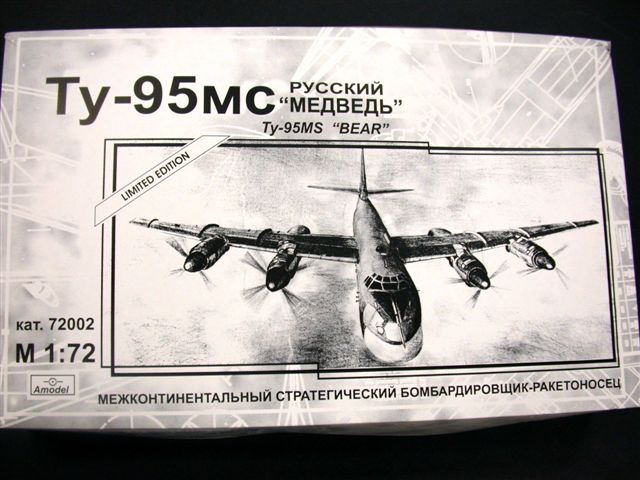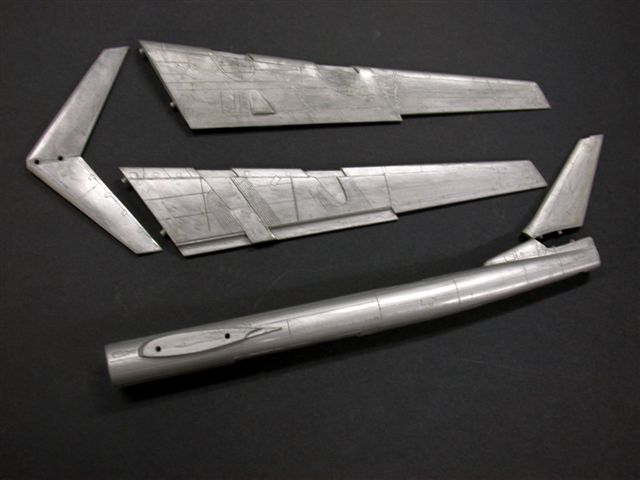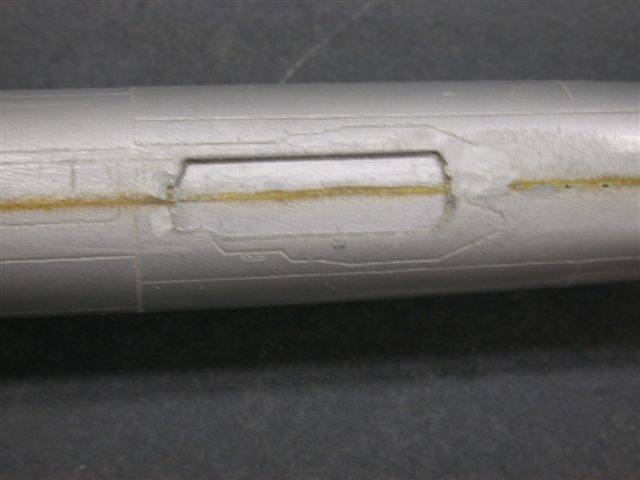|
1/72 Tu-95MS "Bear H"

Amodel

HyperScale is proudly supported by Squadron.com
S
u m m a r y
|
| Catalogue Number: |
72-002 |
| Scale: |
1/72 |
| Contents and Media: |
See Text |
| Price: |
USD$139.00 Obtained from Linden Hill
Imports |
| Review Type: |
First Look |
| Advantages: |
Epoxy glass construction overcomes "vacform
droop"; innovative; petite injected details; decent instructions. |
| Disadvantages: |
Complications with cleanup and
rescribing due to hard epoxy; lots of cleanup and flash on styrene parts;
some warpage evident; flat-finish decals |
| Recommendation: |
Recommended to experienced modelers,
but finicky Tamiyagawa assemblers need not apply! |
Reviewed by "Bondo Phil" Brandt
FirstLook
- The Bear is Here
|
Hot on the heels of their Sukhoi T-4 release, the first in their
"Monster Plane" series, the Russian firm, Amodel, has stepped smartly up
to the plate with another Soviet giant airframe, the definitive Tu-95MS,
or "Bear H." Although quite innovative, this latest limited production
(200 copies) kit is certainly not the first 1/72 Bear to be produced.
Contrail did vacuform kits of the Bear and AWACS "Moss" (with injected
props and rudimentary landing gear) some twenty years ago, and in the
past two years, AIM in the U.K. has produced a precut vac kit with resin
components. What sets this new Amodel release apart from the others is
the serious price--Linden Hill Imports immediately sold out their
initial USA allotment, however--and, as in the case of its T-4
predecessor, the main fuselage, wings and tail are all done in tough,
hand-laid epoxy fiberglass, with a host of injected add-ons to be
attached with CA glue.
While epoxy glass certainly overcomes 'droopy' vac construction
problems inherent in long fuselages and large wingspans--you could kill
someone with these epoxy glass parts!--it comes with its own baggage,
namely quality of engraving.

The overall panel engraving on the smooth epoxy glass surfaces is OK
on such a large model, if perhaps a bit aggressive, approaching Matchbox
in some areas, and too light in others. IMO the uneven engraving results
from the gelcoat and laying on of the glass cloth. Then, when the
component halves are epoxied together, and the resulting seams sanded at
the factory, additional details, sometimes complex lines, are
obliterated....which would still be OK in this age of neat scribers if
it weren't for the hardness of the gelcoat. I tried to "hog out" some
shallow panel lines with my Bare Metal scriber, bearing down more and
more with each pass, with little success. I plan to try my thin Hasegawa
panel saws next; stay tuned.

Some twenty smaller sprues of soft plastic injected components are
generally well done, with petite, even scribing. Allow lots of time for
parts cleanup, though, because the horde of injected components come
with typical limited production, industrial-sized spigots, not only
where they join the sprues, but spread onto flat joining surfaces, too,
Click the thumbnails below
to view larger images of kit parts:
And, we haven't even mentioned flash which is well-represented also,
along with just a few sink marks.
I did a dry fit of the forward fuselage/cockpit halves, and there is
warpage, so I'd glue the halves together progressively, after each
section dries. Control surfaces--and there are a group of these--will
need the builder's tender care also. Note that Bondo sez "builders";
finicky Tamiyagawa assemblers need not apply for this project! In fact,
if my previous Amodel experiences are any guide, everything will have to
be fine tuned before gluing.
Engines
The four big Kusnetszov turboshafts are multipiece assemblies with the
cowlings done in halves, actual depth to the concentric ring intakes
(1/2") and add-on oil cooler scoops. The contra-rotating prop assemblies
are constructed of individual prop blades and actually rotate on
concentric shafts. Exhaust stacks are also cast in halves, and a turbine
wheel can be seen inside the nacelle as in the real thing.
Landing Gear
The complexities of the main and nosegear assemblies have been
realistically rendered by Amodel and are comprised of numerous spindly
struts and small parts, all with flash to be removed. The maingear strut
assemblies locate between the interior-detailed halves of the big inner
nacelle pods, a Tupolev design hallmark. The nosegear well is of
built-up construction, with structural detail in the "roof" section.
Wheels are well done with delicate holes in the outer halves.
Flightdeck
The flightdeck is straightforward, with separate consoles and control
yokes. The instrument panel has sunken instrument bezels. Seats matchup
with pix of the real thing, but no belts or harness are included. The
small windscreen and windows won't permit much viewing anyhow.
Wings and Control Surfaces
The epoxy glass wings, horizontal and vertical fins have cast-in dowels
which mount into pre-drilled holes in the fuselage. Flaps, ailerons,
stabilizers and rudder are of built-up construction. Tiny hingeplates on
the stabilizers and rudder glue directly to the flat vertical surface of
the epoxy glass horizontal--BTW, the dihedral of this component is
built-in at the factory--and vertical fins. Flaps appear to be able to
be installed in deployed configuration. Ailerons butt directly to the
epoxy glass wings. Trim tabs for all controls are separate, as are wing,
stab and rudder tips. One subtle Bear H difference picked up by the
Amodel folks are the nacelle transition fairings in the top of each
wing. The H version has gentle, "squashed" contours, whereas earlier
Bears have sharper, more V-shaped ones, somewhat like the engine
pod/wing transition in a B-52.
The decal sheet features both Russian and Ukraine national insignia
with ninety-two separate airframe stencils, all in that irritating
flat-finish so loved by ESCI. Bondo's gonna try to pre-spray the sheet
with Micro Superfilm. I don't believe there are any aftermarket sheets
out there now, but with the imminent release of the Trumpeter Bear, I'm
confident some alternatives will show up.
The Bear H comes with a decent, twelve-page booklet done in no-text
style. Exploded parts assembly are self-explanatory, but I'd strongly
recommend additional references such as the excellent Aerofax book by
Yefim Gordon, or the nice WAPJ article in its Premier Edition way back
in Spring 1990.
The Bear is a much-desired subject by modelers entranced by
instruments of the old "Evil Empire." Amodel's release, while not an
inexpensive afternoon project, and with the comparative roughness of
limited edition kits, is nevertheless a quantum step beyond vacuform
multimedia kits of the past, and this modeler welcomes it.
The forthcoming (May '02) Trumpeter release of the Bear should stir
the waters even more.
Review and Images Copyright © 2002 by
Phil Brandt
Page Created 27 March, 2002
Last updated 20 July, 2003
Back to HyperScale Main Page
Back to Reviews Page
|
Home | What's
New | Features
| Gallery |
Reviews | Reference
| Forum
| Search